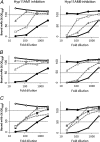Differential occurrence of Streptococcus pneumoniae serotype 11E between asymptomatic carriage and invasive pneumococcal disease isolates reflects a unique model of pathogen microevolution
- PMID: 22267713
- PMCID: PMC3284216
- DOI: 10.1093/cid/cir953
Differential occurrence of Streptococcus pneumoniae serotype 11E between asymptomatic carriage and invasive pneumococcal disease isolates reflects a unique model of pathogen microevolution
Abstract
Background: Streptococcus pneumoniae is a commensal colonizer of the human nasopharynx (NP) that causes disease after evasion of host defenses and dissemination. Pneumococcal strains expressing the newly identified serotype 11E arise from antigenically similar 11A progenitors by genetic inactivation of the O-acetyltransferase gene wcjE. Each 11E strain contains a distinct mutation to wcjE, suggesting that 11E strains are not transmitted among hosts despite their recovery from multiple patients with pneumococcal disease. We investigated whether the presumed lack of transmission of serotype 11E is consistent with its inability to survive in the NP.
Methods: More than 400 pneumococcal carriage, middle ear, conjunctiva, and blood isolates, serotyped as 11A by Quellung reaction, were reexamined for reactivity to 11A- and 11E-specific antibodies. We confirmed serotyping of isolates with sequencing of wcjE alleles.
Results: Serotype 11E strains were statistically more likely to occur among blood (4 of 15), conjunctiva (1 of 14), or middle ear (2 of 21) isolates than among carriage isolates (2 of 355). All 11E isolates contained unique mutations that putatively decrease wcjE expression.
Conclusions: The lack of a circulating 11E clone and the increased occurrence of 11E strains among disease isolates supports the idea that serotype 11E independently arises during infection after initial colonization with a serotype 11A progenitor. Factors encountered in the NP likely contribute to relative rarity of 11E among carriage isolates, whereas selective pressures in deeper tissues possibly promote 11E emergence. These findings illustrate a novel model of microevolution that transpires during the span of a single encounter with serotype 11A, highlighting the adaptability of bacterial pathogens within hosts.
Figures


References
-
- Richter SS, Heilmann KP, Dohrn CL, Riahi F, Beekmann SE, Doern GV. Changing epidemiology of antimicrobial-resistant Streptococcus pneumoniae in the United States, 2004–2005. Clin Infect Dis. 2009;48:e23–33. - PubMed
Publication types
MeSH terms
Substances
Grants and funding
LinkOut - more resources
Full Text Sources
Other Literature Sources
Medical
Miscellaneous

